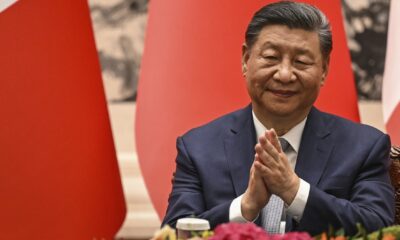China
Outlook for China’s Wine Market: Current Trends and Opportunities

China’s wine market faces challenges like declining consumption and imports, but remains resilient. Adapting to consumer preferences, focusing on quality and sustainability, and using digital platforms for sales are key strategies. Despite setbacks, the market is promising for foreign producers.
Despite challenges such as declining consumption and import figures, China’s wine market remains resilient and promising. Strategic adaptation to evolving consumer preferences, emphasis on quality and sustainability, and leveraging digital platforms for sales are pivotal strategies for success in this dynamic and competitive landscape.
In recent years, China’s wine market has faced significant challenges marked by declines in key metrics such as consumption, imports, and domestic production. These difficulties were further compounded by the disruptions brought about by the COVID-19 pandemic. Despite these setbacks, the market retains its allure, presenting opportunities for foreign wine producers and exporters who are willing to adapt and strategically engage.
As consumer preferences evolve and government policies increasingly emphasize quality and sustainability, understanding these complexities becomes crucial for stakeholders navigating China’s evolving wine landscape. By staying attuned to shifting trends and regulatory developments, stakeholders can position themselves effectively to capitalize on the market’s enduring potential.
The wine sector in China has experienced dramatic shifts over the last two decades, initially reflecting rapid growth and then gradually declining. In the early 2000s, China emerged as a lucrative market for global wineries seeking expansion due to soaring wine imports driven by rising consumer wealth and the perception of wine as a symbol of sophistication. However, per capita consumption peaked around 2012, and imports have since plateaued, with recent years showing significant market contraction. The COVID-19 pandemic exacerbated these challenges, particularly affecting wine sales due to its association with social gatherings, which were restricted during lockdowns.
Following this trend, in 2023, China saw a significant decline in wine consumption, with a 24.7 percent decrease compared to 2022. According to the International Organization of Vine and Wine (OIV), China’s wine consumption has been falling since 2018, averaging a loss of 2 million hectoliters annually.
Nevertheless, China remains the ninth-largest wine-consuming nation worldwide.
Looking forward to 2024, China’s wine market is poised for dynamic activity, delineated primarily by consumption settings: at-home and out-of-home. According to Statista, revenue from wine sales in supermarkets and convenience stores (at-home) is forecast to reach US$9.7 billion. In contrast, revenue generated from wine consumed in restaurants and bars (out-of-home) is expected to be substantially higher, totaling US$17.2 billion. This projects the total revenue from the wine market to reach US$26.8 billion by the end of 2024.
This article is republished from China Briefing. Read the rest of the original article.
China Briefing is written and produced by Dezan Shira & Associates. The practice assists foreign investors into China and has done since 1992 through offices in Beijing, Tianjin, Dalian, Qingdao, Shanghai, Hangzhou, Ningbo, Suzhou, Guangzhou, Dongguan, Zhongshan, Shenzhen, and Hong Kong. Please contact the firm for assistance in China at china@dezshira.com.
Business
China’s Golden Rooster Film Festival Kicks Off in Xiamen – Thailand Business News

The 2024 China Golden Rooster and Hundred Flowers Film Festival began in Xiamen on Nov 13, featuring awards, cultural projects worth 31.63 billion yuan, and fostering international film collaborations.
2024 China Golden Rooster and Hundred Flowers Film Festival Opens
The 2024 China Golden Rooster and Hundred Flowers Film Festival commenced in Xiamen, Fujian province, on November 13. This prestigious event showcases the top film awards in China and spans four days, concluding with the China Golden Rooster Awards ceremony on November 16.
The festival features various film exhibitions, including the Golden Rooster Mainland Film Section and the Golden Rooster International Film Section. These showcases aim to highlight the achievements of Chinese-language films and foster global cultural exchanges within the film industry.
On the festival’s opening day, a significant milestone was reached with the signing of 175 cultural and film projects, valued at 31.63 billion yuan ($4.36 billion). Additionally, the International Film and Television Copyright Service Platform was launched, furthering the globalization of Chinese film and television properties.
Source : China’s Golden Rooster film festival opens in Xiamen – Thailand Business News
China
Italy and China New DTA Set to Take Effect in 2025: Important Changes and Implications

Italy ratified an upgraded Double Tax Agreement (DTA) with China, effective in 2025, to reduce tax burdens, prevent evasion, and enhance investment. The DTA introduces modern provisions aligned with international standards, targeting tax avoidance and improving dispute resolution for Italian businesses.
Italy recently ratified the upgraded Double Tax Agreement (DTA), which will finally take effect in 2025. This agreement was signed in 2019 and was designed to reduce tax burdens, prevent tax evasion, and promote Italian investment in China.
On November 5, 2024, Italy’s Chamber of Deputies gave final approval to the ratification of the 2019 Double Tax Agreement (DTA) between Italy and China (hereinafter, referred to as the “new DTA”).
Set to take effect in 2025, the new DTA is aimed at eliminating double taxation on income, preventing tax evasion, and creating a more favorable environment for Italian businesses operating in China.
The ratification bill for the new DTA consists of four articles, with Article 3 detailing the financial provisions. Starting in 2025, the implementation costs of the agreement are estimated at €10.86 million (US$11.49 million) annually. These costs will be covered by a reduction in the special current expenditure fund allocated in the Italian Ministry of Economy’s 2024 budget, partially drawing from the reserve for the Italian Ministry of Foreign Affairs.
During the parliamentary debate, Deputy Foreign Minister Edmondo Cirielli emphasized the new DTA’s strategic importance, noting that the agreement redefines Italy’s economic and financial framework with China. Cirielli highlighted that the DTA not only strengthens relations with the Chinese government but also supports Italian businesses, which face increasing competition as other European countries have already established double taxation agreements with China. This ratification, therefore, is part of a broader series of diplomatic and economic engagements, leading up to a forthcoming visit by the President of the Italian Republic to China, underscoring Italy’s commitment to fostering bilateral relations and supporting its businesses in China’s complex market landscape.
The newly signed DTA between Italy and China, introduces several modernized provisions aligned with international tax frameworks. Replacing the 1986 DTA, the agreement adopts measures from the OECD/G20 Base Erosion and Profit Shifting (BEPS) Project and the OECD Multilateral Instrument (MLI), targeting tax avoidance and improving dispute resolution.
The Principal Purpose Test (PPT) clause, inspired by BEPS, is one of the central updates in the new DTA, working to prevent treaty abuse. This clause allows tax benefits to be denied if one of the primary purposes of a transaction or arrangement was to gain a tax advantage, a move to counter tax evasion through treaty-shopping.
| This article was first published by China Briefing , which is produced by Dezan Shira & Associates. The firm assists foreign investors throughout Asia from offices across the world, including in in China, Hong Kong, Vietnam, Singapore, and India . Readers may write to info@dezshira.com for more support. |
Read the rest of the original article.
Business
China’s New Home Prices Stabilize After 17-Month Decline Following Support Measures

China’s new home prices fell for the 17th month in October, declining 0.5% from September, but slowing, indicating potential market stabilization amid supportive measures. Second-hand home prices showed mixed trends.
Decline in China’s Home Prices Stabilizes
China’s new home prices continued to decline in October for the 17th consecutive month, although the drop showed signs of slowing. Recent support measures from Beijing appear to be inching the market toward stabilization, as evidenced by a lighter decline compared to earlier months.
Monthly and Yearly Comparisons
According to the latest data from the National Bureau of Statistics, new home prices across 70 mainland cities fell by 0.5% from September, marking the smallest decrease in seven months. Year-on-year, prices dropped by 6.2%, slightly worse than the September decline of 6.1%. In tier-1 cities like Beijing and Shanghai, prices decreased by 0.2%, a smaller fall than 0.5% in the previous month.
Second-Hand Home Market Trends
Second-hand home prices in tier-1 cities experienced a 0.4% increase in October, reversing a 13-month downward trend. Conversely, tier-2 cities observed a 0.4% drop in second-hand prices, while tier-3 cities faced a similar 0.5% decline. Overall, recent trends indicate a potential stabilization in China’s property market.
Source : China’s new home prices slow 17-month decline after support measures kick in











